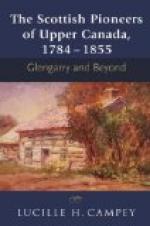Except that the ships of Bristol still no doubt continued to resort to the banks of Newfoundland for fishing, and that even the captains of these ships were occasionally elected admirals of the French, Basque, Portuguese, and English fishing fleets during the summer, the English, as a nation, took no part in claiming political dominion over North America after the voyage of Captain John Rut in 1527. This was the fault of Sebastian Cabot, the son of the man who founded British America, and who had returned to England long afterwards as the Grand Pilot appointed by Edward VI to further the discovery of a northern sea passage to China. Through him the attention of adventurers for a time was diverted from America to the “discovery” of Russia (as it has been called). The efforts of Sebastion Cabot were directed towards the revelation of a north-east passage by way of Arctic Russia to the Pacific, rather than past Newfoundland and Labrador and across Arctic America.
But as soon as Elizabeth came to the throne the sea adventurers of Britain, freed from any subservience to Spanish wishes, developed maritime intercourse between England, Morocco, and West Africa on the one hand, and Tropical and North America on the other. Once more the discovery of the North-west Passage across America to China came into favour. MARTIN FROBISHER[1] offered himself as a discoverer, and the Earl of Warwick found the means which provided him with two small sailing vessels of 25 and 20 tons each, besides a pinnace of 10 tons.[2] Queen Elizabeth confined herself, in the way of encouragement, to waving her lily hand from her palace of Greenwich as these three little boats dropped down the Thames on the 8th of June, 1576. She also sent them “an honourable message”, which no doubt reached them at Tilbury.
[Footnote 1: The name was also spelt Furbusher, and in other ways. He became Sir Martin Frobisher over the wars of the Armada, and died Lord High Admiral of England in 1592.]
[Footnote 2: It may be of interest to set forth the kind of rations shipped in those Elizabethan times for the food of the sailors. According to Frobisher’s accounts these consisted of salted beef, salt pork, salt fish, biscuit, meal for making bread, dried peas, oatmeal, rice, cheese, butter, beer, and wine, with brandy for emergencies. As regards beer, the men were to have a ration of 1 gallon a day each. Altogether it may be said that these rations were superior in variety—and no doubt in quality—to the food given to seamen in the British merchant marine in the nineteenth century.]
But the pinnace was soon swallowed up in the high seas; the seamen in the vessel of 20 tons lost heart and turned their ship homewards. Frobisher alone, in his 25-ton bark, sailed on and on across the stormy Atlantic, past the south end of Greenland, and over the great gulf that separates Greenland from Labrador. He missed the entrance to Hudson’s Bay, but reached a great “island” which he named Meta Incognita[3]. Here he gathered up stones and, as he believed, minerals, besides capturing at least one Eskimo, and then returned.




